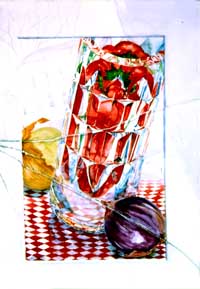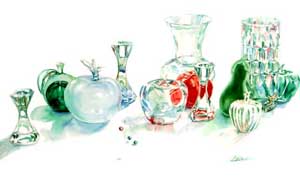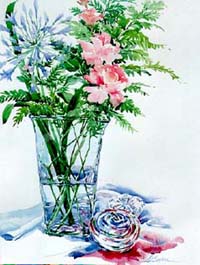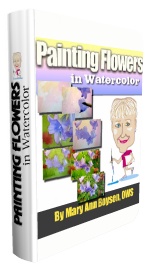Lesson 11
By Mary Ann Boysen
Painting crystal is an exercise in observation and a challenge that I love. I am sure that people who paint crystal make still life set-ups, photograph them in slide form, and project the image directly on to their painting surface. That would be the easiest way to draw it accurately and believe me, I am tempted sometimes but I like to challenge my hand-eye coordination to the limit and do the drawing from life. |
Related topics:
Painting Lace
Painting Reflections |
I carefully choose several shapes of crystal, and perhaps a piece of lace I can use as a background. I make an arrangement on the table in front of me, or on the floor beside me. Whichever angle I want for an effect. This is where the MOOD comes in. What I set up one day may not be the thing that I want to paint the NEXT day.

After I have drawn each piece carefully, I decide which piece I want to repeat. I pick it up in my left hand, turn it to the angle that I want, find a place it will fit in the scheme of things, and begin to draw it at that angle. It may be in a horizontal position, or I might be looking directly down on the top of it. I repeat the drawing process until I have completed a design that pleases me.
Here is how I begin to paint crystal
Good crystal is perfectly clear. Most of the crystal I paint is cheap, so I ignore the lack of clarity and make it look expensive.
The only colors and shapes that you see are caused by reflections from adjacent objects, or actual objects that you can see through the surface of the glass, such as flower stems or objects that may be across the room. Glass has a bluish or greenish color, so you can begin with some shapes using those colors.
 If the crystal is a simple, unadorned vase or pitcher, all you see are shapes that follow the contour of the object. If the vase is a perfect cylinder, the shapes, will be vertical "rods" of color. If an object is reflected in the vase, it may take on its own shape, though it may be somewhat distorted. Some of the shapes you will see will be dark in color, and some will be soft edged. Concentrate on exactly what you see and either draw it first, or just pick up some color with your brush and begin to paint! If the crystal is a simple, unadorned vase or pitcher, all you see are shapes that follow the contour of the object. If the vase is a perfect cylinder, the shapes, will be vertical "rods" of color. If an object is reflected in the vase, it may take on its own shape, though it may be somewhat distorted. Some of the shapes you will see will be dark in color, and some will be soft edged. Concentrate on exactly what you see and either draw it first, or just pick up some color with your brush and begin to paint! 
If the vase is a short, fat, round one, the shapes you see will follow the contour of the vase. If the vase has facets, such as cut-glass, each facet will have reflections in it, and they will follow the direction of the facet. If the vase is extremely ornamental in its facets, you can practically fake the reflections that you see.
The only drawing I do is the outline of the object. The rest of the shapes are laid in with a brush. I believe that the more you labor over a painting, the more labored it looks. The fresher look comes from a simpler approach means direct painting of the shapes. If they don't look exactly like what you see, no one is going to know.
You will find that the shapes change each time you shift from one foot to the other. It is fine for you to change the shapes in the painting.

The impression you give is more important than an accurate drawing of the object.
The procedure for painting crystal is much the same as painting lace....actually, exactly the same! However, with the crystal you might be seeing what is inside the crystal or what is beyond it, since it is totally transparent. It is those colors that will be determining what colors to use in the execution of the painting. I start by drawing the main design, then repeating it until I have memorized it. (If the crystal is very ornate, you can cheat by doing many little strokes in the direction of the design, changing colors frequently). But if the cut glass is a simple design, such as in this image, you must memorize the pattern. Treat each little facet as a separate painting. Don't panic by looking at the total image and frantically worrying about "how will I ever do this?" 
Next is a painting of a crystal vase with which I took some liberties. I put a large red pepper inside so that it would be a brilliant contrast to the glass. In each broad facet of the crystal I painted the red shape that I saw. One at a time....and they were all a bit different. Notice the light space between the facets. This is the light that you see at the edge of the cut. This also helps to define each facet of crystal. In the bottom of the vase you can see through the crystal. The red checked tablecloth shows up and it is distorted because of the curve of the glass. Also you see a bit of the purple onion reflected in the crystal. All these things make up the body of the painting. You will also notice that I painted the edge of the painting to look like a mat, and I added cracks across the face of the painting to look as if the glass was broken. I also painted what appears to be faint reflections in the glass. In the bottom of the vase you can see through the crystal. The red checked tablecloth shows up and it is distorted because of the curve of the glass. Also you see a bit of the purple onion reflected in the crystal. All these things make up the body of the painting. You will also notice that I painted the edge of the painting to look like a mat, and I added cracks across the face of the painting to look as if the glass was broken. I also painted what appears to be faint reflections in the glass.
I entered this painting in a juried competition. It was accepted, and I was called by one of the committee workers to see if I would like to pick it up and have the glass replaced before the show opening. Oh, how I laughed.
Painting smooth clear glass poses another problem. It does not have facets that you can treat as individual little paintings, so you must treat the whole, or concentrate on what is inside the glass, as that is the little painting that you must concentrate on.
 Here, the Lalique apple is not transparent, but transluscent. It has only a hint of the green glass that is behind it on the left side. The clear glass apple is clear, so it is easy to see the red object behind it. Likewise, the faceted vase (the same that I used in the previous illustration) has a green object behind it, so each facet is painted thusly. Here, the Lalique apple is not transparent, but transluscent. It has only a hint of the green glass that is behind it on the left side. The clear glass apple is clear, so it is easy to see the red object behind it. Likewise, the faceted vase (the same that I used in the previous illustration) has a green object behind it, so each facet is painted thusly.
The following is a vase faceted vase that is loaded with flowers. Stems are in every direction in the water. It is a mish-mosh of greens, blues mingled with some of the colors of the flowers which are reflected in the glass. Even the shadow below has a repeat (in a lighter value) of the colors in the vase. SHADOWS ARE NOT GREY! They are every color of the rainbow! They also carry reflected light from the subject casting the shadows. That is another entire chapter!

Now, I hope you understand more about patterns found in lace, cut glass, and smooth crystal. It takes a bit of practice to get this right, but you can do it. All it takes is dedication to practice and the desire to succeed. Remember what it takes to get to Carnegie Hall. (practice, practice, practice)
Colors
Transparent color should be the first ones used in the painting of transparent object. Remember to match your paint to the subject at hand.
The best colors for crystal are the transparent ones. Many of them are staining but have an exquisite clarity to them. Try Cobalt Blue, Cobalt Blue Hue (H), Rose Madder Genuine, Opera (H) or Wild Fuschia (AJ), Viridian, any of the Quinacridone colors, and the Thalo pigments. Make the colors sing by using complements whenever possible.
Lay the complementary colors side by side to give PUNCH to the painting. Mixing the complements on your palette produces gray. Allowing them to blend on the paper without your help, creates a transparent glow. Remember to add colors from other areas of the painting to the crystal when you need to repeat a color, even if you do not see it. The viewer will think you are brilliant!
Let's Reflect
Working in paintings of crystal, plain glass, & water, can cause an observation problem. As you look at the subject you see only reflections in the glass, or that which is on the other side of the surface.
If you close one eye, the position of the subject changes slightly. Now, close the other eye and see a completely different design. If you move your head slightly, the subject changes again.
It is up to you to choose the design you like. Due to the nature of the subject, it is not necessary to be totally exact in your representation of the subject. If you desire photo realism, you can achieve the result without it being a totally photo-like representation of the subject you are seeing. In watercolor it is more fun to allow the paint to create the subtle changes in value all by itself. Each facet of the crystal can be considered a small painting. Each facet can be a loosely painted subject within sharp edges, which, from a distance will produce the look of photo realism..
There are several things you can do. One is to photograph your still life, and work from a subject that does not move at all. The only drawback to that is that it is difficult to change anything. You tend to just copy what you see, and does not stretch your mind.
Another procedure is to hold a viewfinder over a portion of the subject, whether it be the actual subject or the photograph, and draw only that portion. Then you have actually conquered a portion of the subject and have accomplished the task of SIMPLIFICATION.
This last procedure is an exercise in redesigning the subject, creating something totally unique, not just a copy of the total picture. The unusual is more creative on the part of the artist, and it is more entertaining to the viewer.
This is probably the best approach to the subject. It is easier than doing an entire still life, and it is the most individually creative in its results. If, after you have mastered this form of painting glass, you wish to move ahead and work on an entire still life of glass, you will be more familiar with your subject, and the process will be much easier.
Exercises in Painting Crystal
- On your sketchpad or your watercolor paper, draw several rectangles approximately 3" x 5". Set up one vase, bowl, or glass on the table in front of you. Place a colorful object behind or beside your subject.
Hold a viewfinder over a portion of it and draw only what you see. Move the viewfinder to another part of the subject and draw this in the next square. Continue this procedure until you have filled at least four rectangles. Now you are ready to choose the one with the best design.
- Begin to paint the small sketch, choosing clear colors. Remember that glass has a little color, but treat it for the moment as if is is totally clear, and the only colors you are seeing are the ones reflected in the glass. At some point you may want to give a portion of the glass a little color at its thickest point for density.
- Now you are ready to transfer the image to another sheet of watercolor paper. Enlarge the sketch to a "do-able" size for you. Make changes if you deem it necessary. Then you are ready to create another painting.
You may even use ARTISTIC LICENSE to change colors if you like
- Rearrange your still life. Add another subject to it, like flowers, a patterned cloth or lace. Use the viewfinder once again, and repeat the procedures in the last exercise.
If you are using lace, I recommend using a Xerox copy of it. Do this by placing it flat in a copy machine. Lay a dark piece of paper on top. Close the machine and make a copy of it. You may shift the lace in the machine to make a copy of another part of the design. This to be a much easier way to see the lace pattern from a distance. Due to the crowded space in my studio, I usually put my still life set-ups on the floor, and at that distance, the lace pattern eludes me, unless it is a Xerox.
- You will notice that the patterned cloth, or lace, will be reflected in the glass or crystal that you have put on top of it. This will create another facet of your design. Don't let it confuse you. Just keep it as simple as possible. The actual detail is not important because the viewer will never know what it really looked like.
Try a different approach
Change your viewpoint of the subject. Place your subject in front of you for one drawing. Place it on the floor for another perspective. Place it on a table, and while sitting on the floor, look up at your subject. It will even be more interesting if the table is glass! Dare to be different!

<< Lesson 10: Watercolor Figures and Faces
Lesson 12: Watercolor Painting Lace >>
Return to Watercolor Techniques
Return to Watercolor Lessons
Watercolor Painting Tips

|
My E-Books

Learning the Basics of Watercolor

Painting Flowers in Watercolor

Painting on Watercolor Canvas
|

